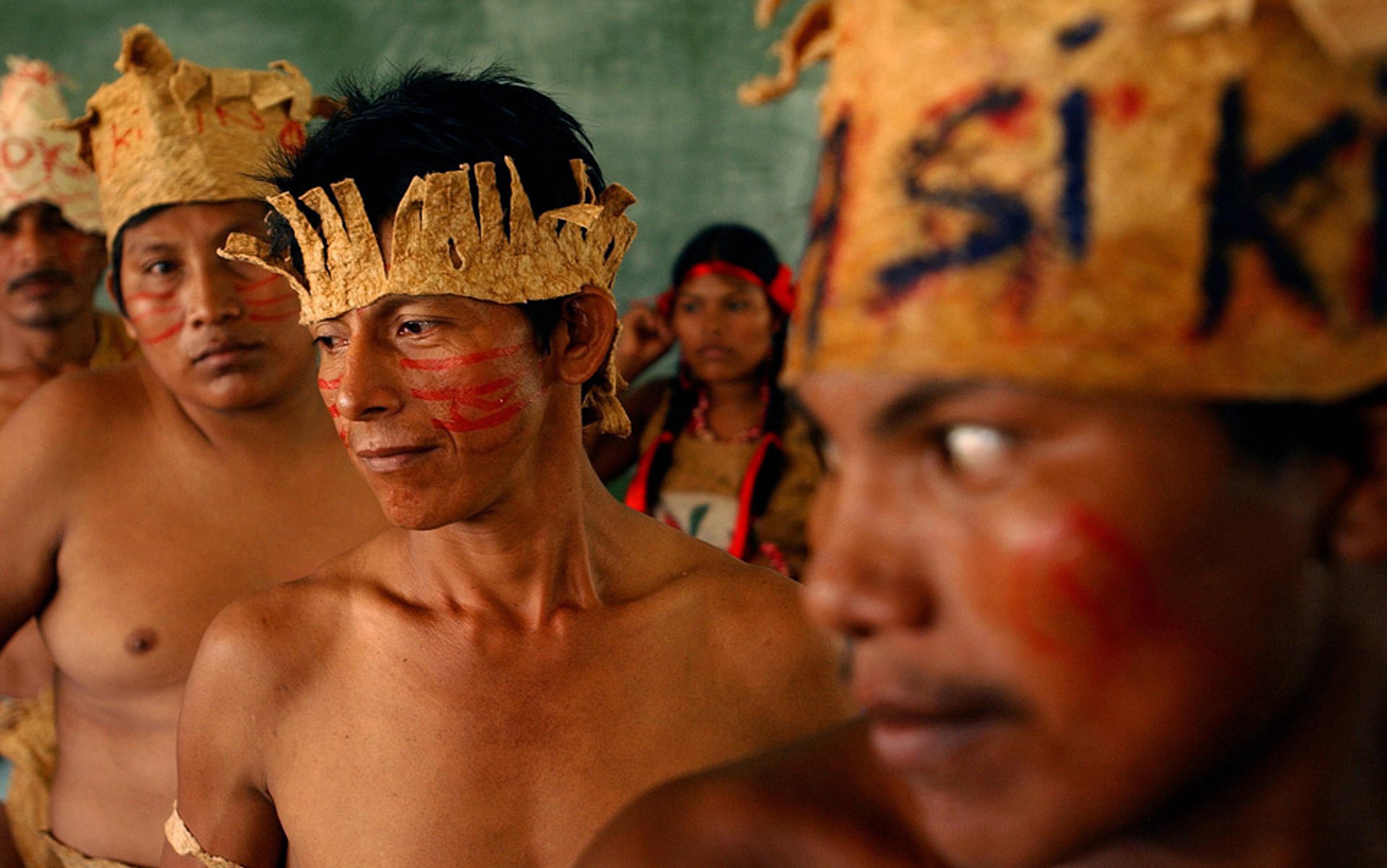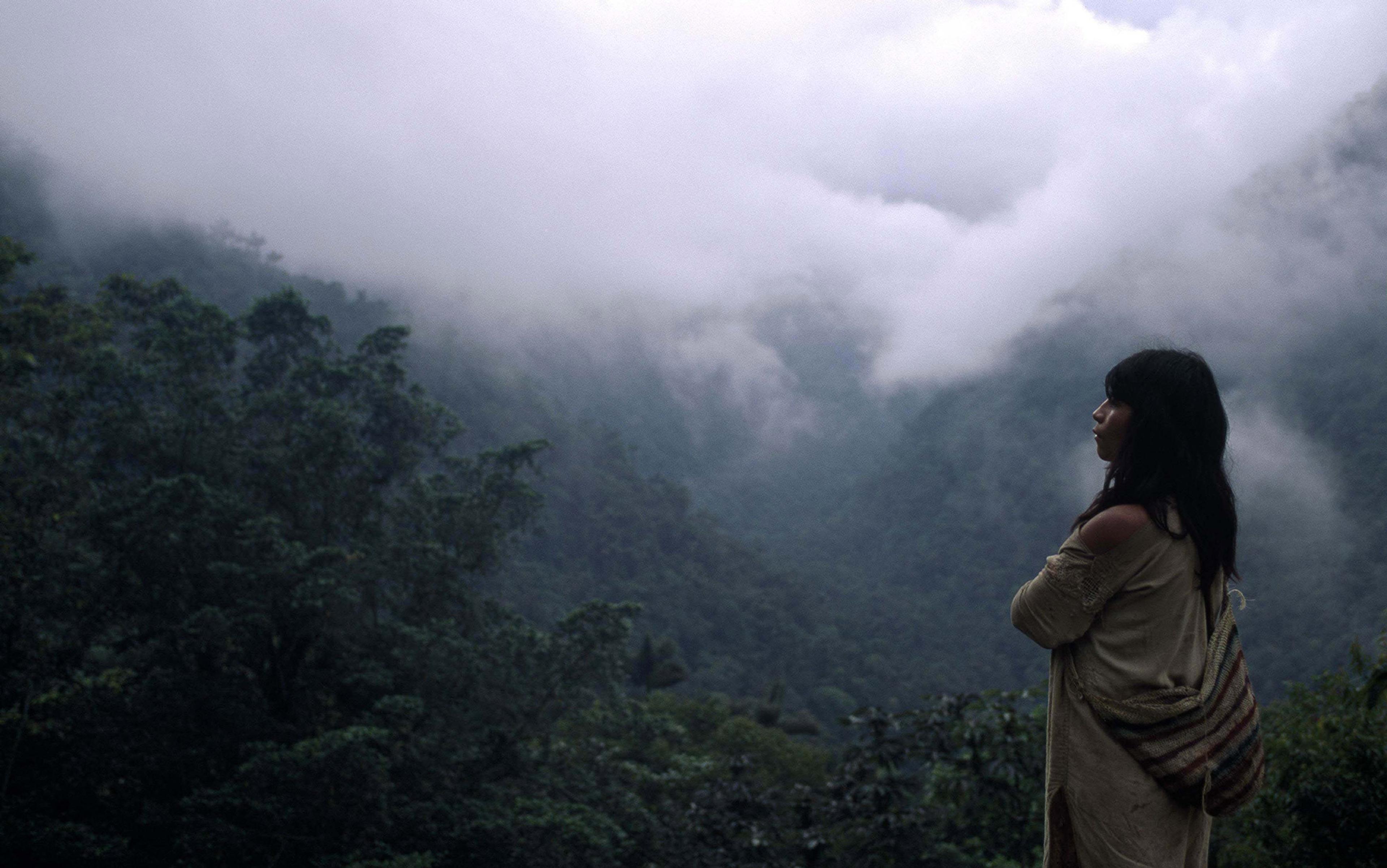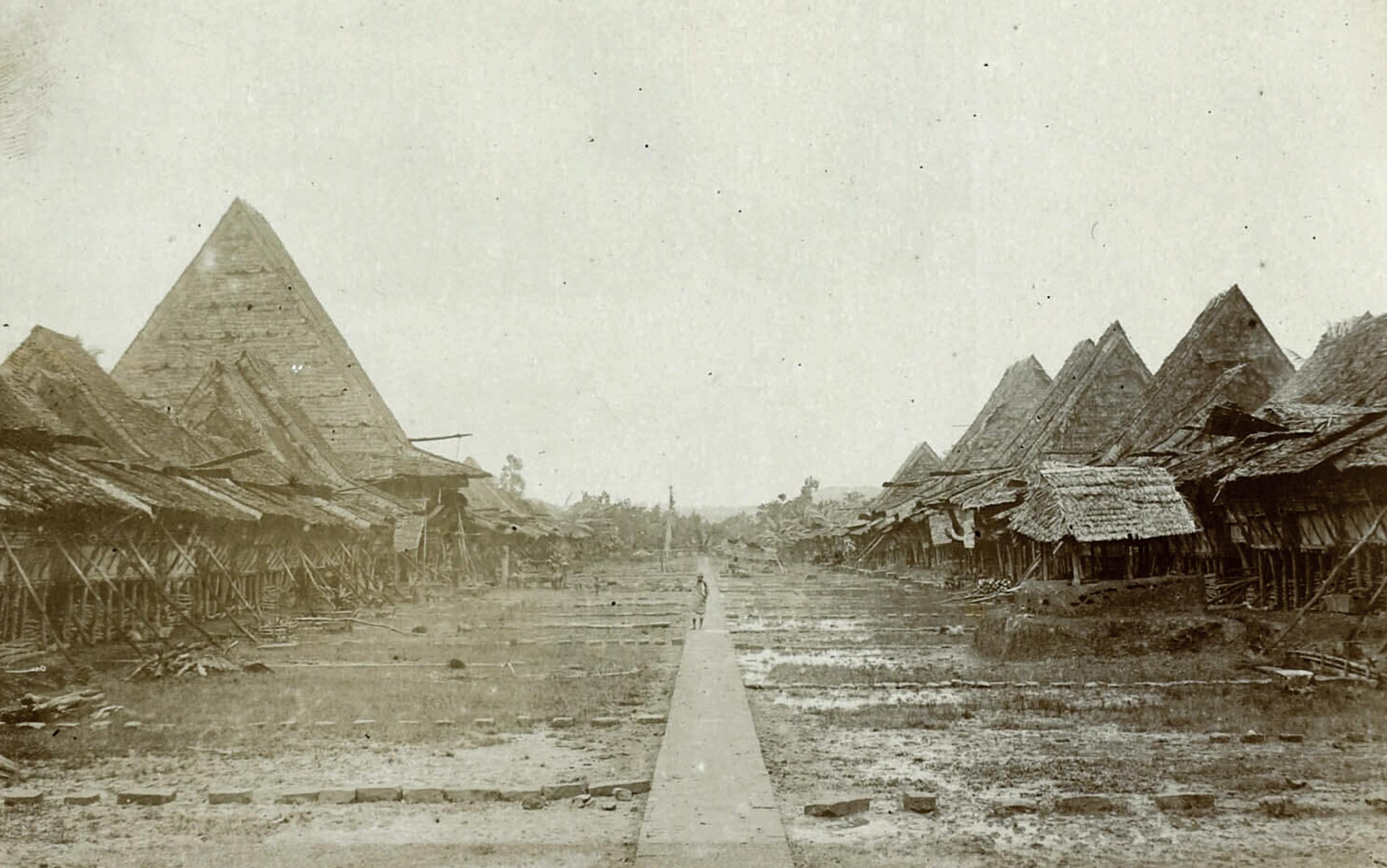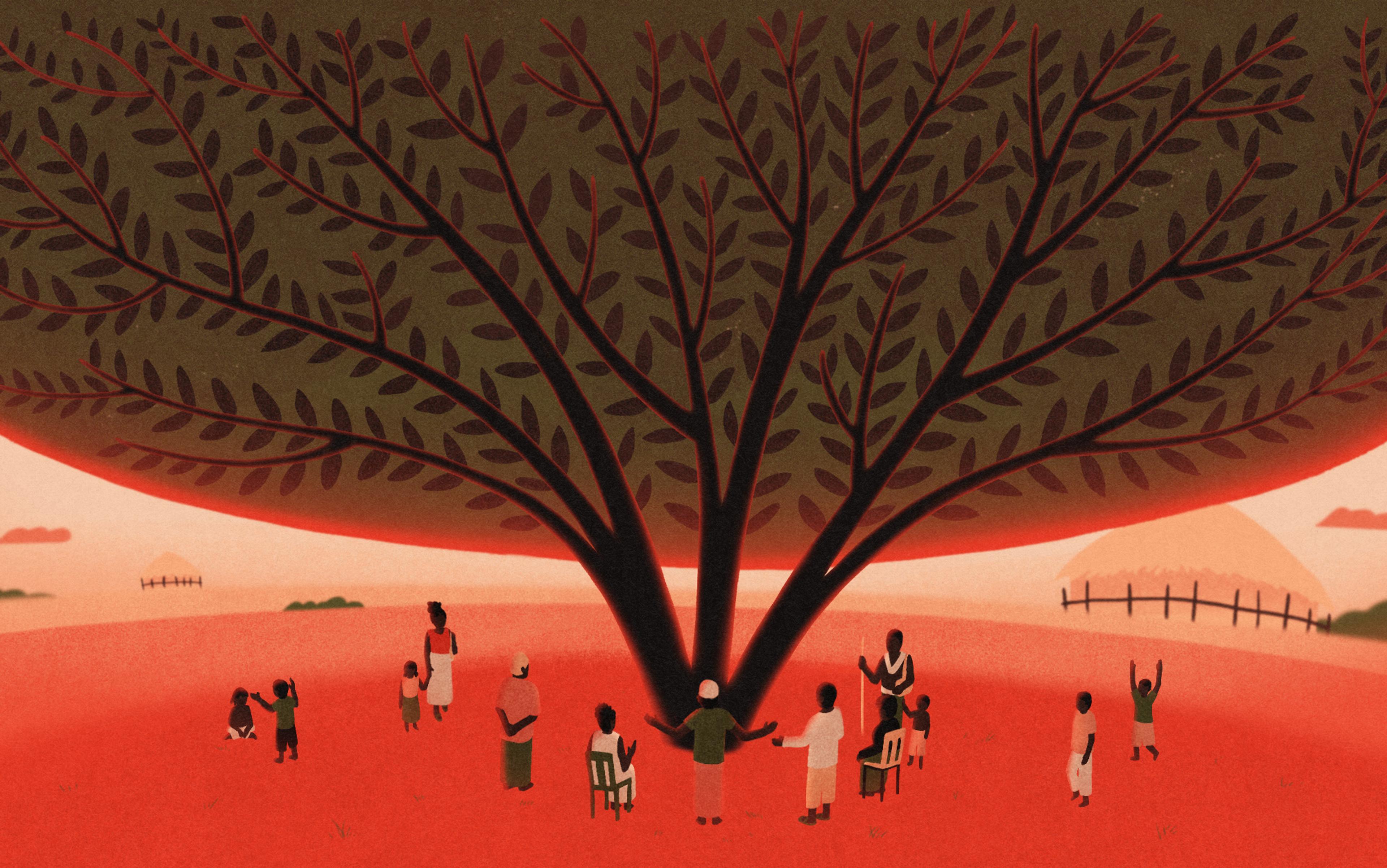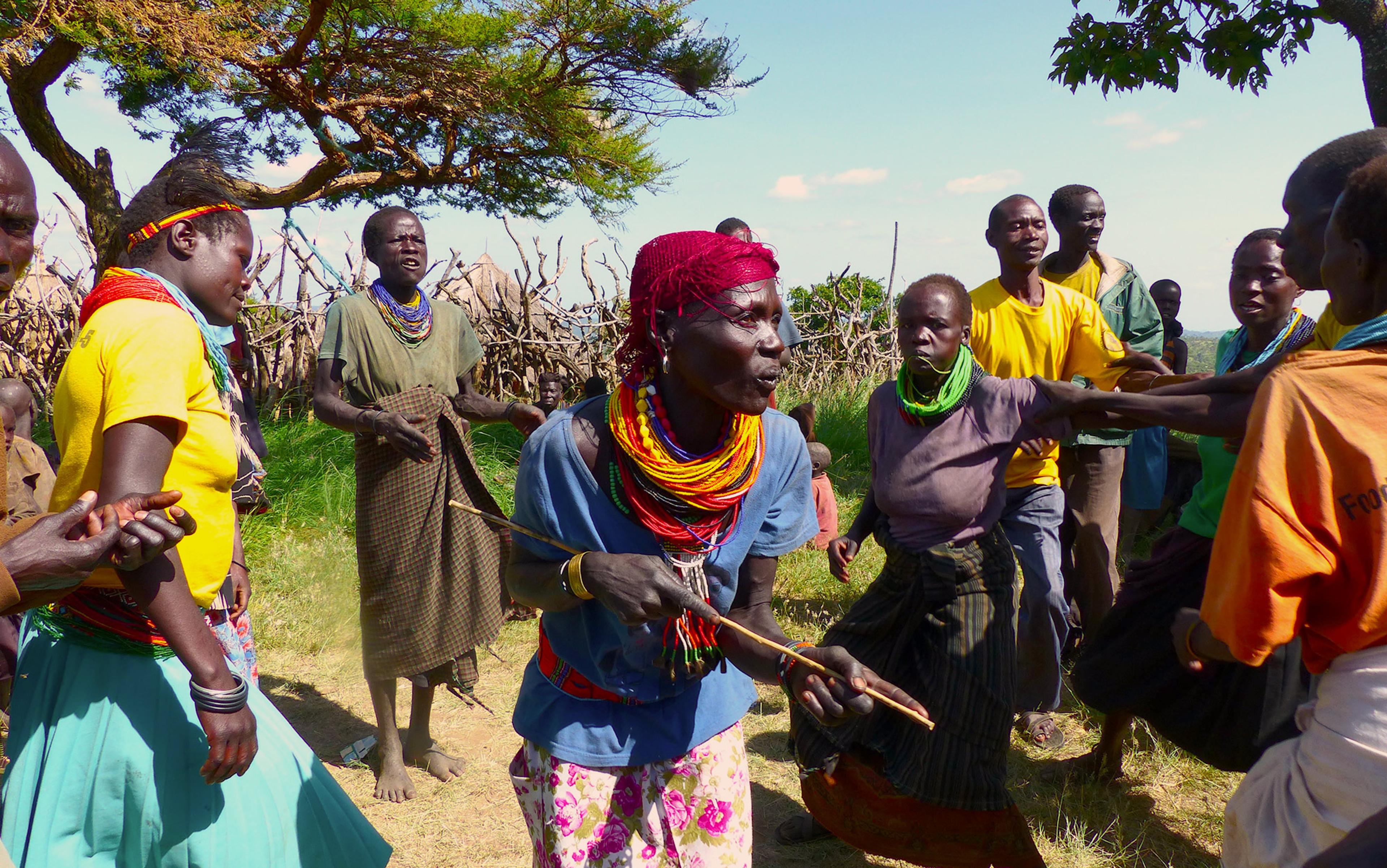The road through the jungle from the gold-rush town of Bonanza to the tiny Mayagna settlement of Sunawas is dead straight. If you know Nicaragua at all this would strike you as very odd. Another striking thing about this particular highway is its colour. Here, where it rains 340 days a year and the eye is bombarded by a primal tangle of every kind of green, the Bonanza-Sunawas road is defiantly red.
When I travelled along it eight years ago the first phase of construction was underway. The road promised to tunnel 8.3km through an antique vegetal tumult of lianas and granadilla, ceiba and mahogany trees into one of the last surviving tracts of lowland rainforest in Central America. A second phase was planned to extend the route another 10km or so from Sunawas to Musawas, on the fringes of the Bosawás Biosphere Reserve — an area about the size of El Salvador, home to about 15,000 Mayagna Indians and, excepting the Amazon, the largest expanse of pristine rainforest on the planet.
Phase one was to cost 4.5 million córdobas, just under $200,000 (or around £120,000). It was an unfeasible sum for the Nicaraguan government, so 95 per cent of the funds were provided by the Danish government’s development organisation, DANIDA, with the remaining $10,000 raised by the local municipality. Both the national transport ministry and the local authorities were in favour of the project, which would open up a previously remote area, halving the journey time from Musawas to Bonanza, and making it easier for locals to take their goods to market and ferry the sick, elderly and pregnant to the nearest clinic. Mayagna community leaders were also broadly positive. But there were those who worried that the road might change their lives in unpredictable ways.

Back-breaking work: Mayagna Indians hand-shovel earth to build the road to Sunawas through the rainforest of north-eastern Nicaragua. Photo by Stina Lindholm
That the money had gone through and construction began is itself a minor miracle. It’s hard to get anything off the ground in Nicaragua. I moved to the country in 2002, seduced by its spectacular landscape and tortured history but, above all, drawn to the place by a love affair with Rigoberto Sampson Davila, a Nicaraguan doctor.
It is June 2004 and Rigo and I are making our way along the new road with the aim of exorcising some old ghosts. Rigo came this way in the late ’80s, as a 19-year-old Sandinista conscript. His family had returned to Nicaragua 10 years before, from a comfortable exile in New York City — where Rigo’s father, Rigo Snr, was training to be a cardiac surgeon — to join in the revolution against the dictator, Anastasio Somoza. Rigo Snr soon found himself in charge of medical services for the Sandinista guerrillas. For two years the family hid out in a remote hut in the forest, hoping Somoza’s death squads wouldn’t find them. Rigo Snr would often be away for weeks at a time, the first news of his return coming only when the door creaked open late one night and the familiar, loved, face appeared, only to disappear again into the forest before the sun came up.
Until now the only alternative to machete-ing a path through the forest has been to paddle along the crocodile- and snake-infested rivers in dug-out pirogues
The camp to which the teenaged Rigo had been conscripted lay just north of where we are now, on the border with Honduras. For months, his life consisted of long spells of crazed, anxious boredom interspersed with sudden, terrifying engagements with an ‘enemy’ he could neither see clearly through curtains of mist, nor bring himself to hate. War exacts an inescapable price on all those touched by it. The Revolution and the subsequent Sandinista-Contra war had left Rigo tormented by guilt, and a feeling of powerlessness. As a teenager, he had been forced to use his AK47 or face death. He had no idea how many lives he had taken, though he did know that some of them were likely to have been Mayagna Indians, whom the counter-revolutionary Contras employed as jungle guides.
After the war, Rigo followed his father into medicine. But, over the years, the spirits of the fallen had come to haunt him all the more for their numberlessness, the blanks of their faces. How to grieve for the lives of those you have taken when you cannot count them? How to atone?
This is where the new road comes in. Or, rather, the journey we are making, of which the road is part. Rigo is hoping that the completion of the road in a few years time will make further trips here unnecessary. But until then, many of the 15,000 Mayagna Indians who live in and around the Biosphere have no access to the clinic in Bonanza, so we are hoping to bring a rudimentary health service to the four Mayagna settlements of Sunawas, Musawas, Nazareth and Bethlehem. We’ll begin walking on the road, travelling the remainder by dug-out pirogue. We have allowed four days for the trip, but time is elastic here and the only predictable element of the journey is the rain.
Even by the standards of Nicaragua, bested only by Haiti in the Latin American poverty rankings, the Mayagna are poor. For the most part they do not speak Spanish, and with burgeoning and vocal Mestizo and Carib populations on the Atlantic and Caribbean coasts to deal with, successive Nicaraguan governments have found it very easy to ignore them. Their infant mortality rates compare with those in most impoverished parts of sub-Saharan Africa. Their average lifespan is 47. Most live by growing corn, rice and bananas in tiny gardens cleared from the jungle, and supplement their diet with fish, birds and forest animals. It’s a subsistence living, though it is now threatened by newcomers to the area who understand that while the region is remote, unmapped, and largely inaccessible, it is also potentially rich: these incomers stand to gain as much from the road as the Mayagna themselves. Yet the Mayagna rightly see themselves as the custodians of the last surviving primary rainforest in Central America, an area more biodiverse than the US, Canada and Mexico combined.
The Danish development agency DANIDA daily makes difficult decisions about where to direct resources, but its agents have decided that the road will be a lifeline investment. Until now the only alternative to machete-ing a path through the forest has been to paddle along the crocodile- and snake-infested waters of the Coco, Waspuk and Pis Pis rivers in dug-out pirogues. The road, this bright artery, is a kind of miracle, an antidote to the slow and serpentine progress imposed by nature in these parts: a straight red road to progress. If Mayagna leaders hadn’t been generally in favour of the project, DANIDA would not have begun to build it.
From Sakalwas, where the road currently begins, the nearest town, Bonanza — with its terraces of hardscrabble shacks, its skinny, dead-eyed livestock and transplanted, Mestizo population — already feels very distant. At Bonanza, life is dominated by the constant crank of the gold mine and the simmering tension of the nearby pool hall where incoming miners blow their wages on Flor de Caña rum and hard-faced Mestizo women. A little way from the mine and the pool hall, on the track back to Sakalwas, a black-silvery tailings pond stares blankly up at the sky, its cyanide-rich waters surrounded by a cracked concrete retaining wall. Another technical solution, albeit a somewhat elementary one.
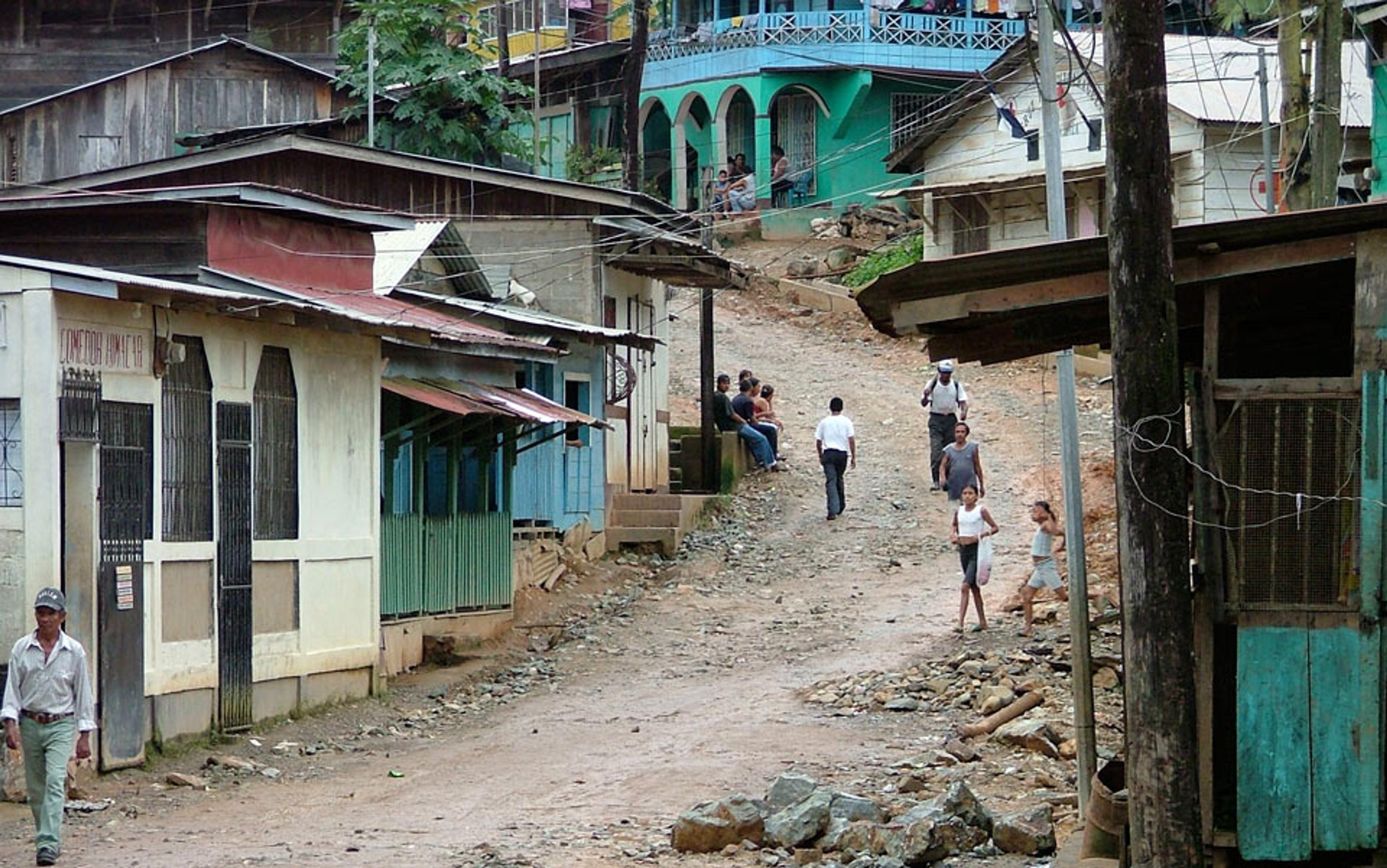
Cheap labour: Mestizo miners blow their wages here in Bonanza on rum and women. Photo by Stina Lindholm
The few Bonanzans employed on the road rather than in the mine will find themselves in a huge tented workers’ encampment not far from Sakalwas. DANIDA has set up six work groups of around 35 people each — four Mayagna, one Mestizo, plus a single group of women (mixed Mayagna and Mestizo). The plan is to rotate the groups so that around 1,000 people will eventually find employment.
The work is shamingly hard. In order to maximise the number of jobs, DANIDA has minimised the use of the plant. Today, in 36C temperature with 100 per cent humidity, small, wiry men in rubber boots are spading the thick, sodden clay into wheelbarrows, maneuvering across planks slick with mud, and emptying them by hand onto giant piles of sloppy red spoilage, stopping every so often to catch their breath and rub the ache from their backs. It’s no easier for the women, whose job is to stand bent in black water all day sifting gravel from the creekbed to use as ballast, and processing it through a mill into giant piles. Their children, who do not go to school, play on the bank beside them or simply sit, eyes unfocussed, expressions of vacant boredom on their faces.
Since the road is incomplete, Rigo and I must travel most of the distance in the traditional way, by river. Two dug-outs are waiting for us on the banks of the Waspuk, along with a handful of thin, raddled men, with the caved-in, desiccated appearance of de-juiced fruits. An elder sits among them, too frail to paddle, with a quiver on his back containing arrows and a spear for fishing. We clamber in, and as the men push off from the bank I turn to the elder to ask him about the road, but he only tips his head and, with a jolly smile, says in broken Spanish, ‘Tengo cien treinta siete años’. ‘I am 137 years old’. Maybe that’s all the Spanish he has, or perhaps he means to say, ‘the road is coming too late for me’.
I’d like to talk with him in the Mayagna language, of which I know just a single word, ‘was’, meaning water. ‘Was’ is one of the Mayagna realities. The Mayagna world is ropes of rain twirling from the vines. It is a reticulation of rivers and creeks and tiny tributaries, many still unnamed on official maps: la red, they say in Spanish, the network.
Now that I think about it, the old man’s estimation of his age might have something to do with another Mayagnan reality. The worlds of the dead, the living and the ethereal lead a blended existence here. Ancestors of the long dead mingle daily with the living and with the spirits of those not yet born. The past, the present and the future exist within the same fluid frame of reference. They bleed into one another, like dyes cast on water. The old man’s 137 years might be an expression of the span of time he feels part of, or in contact with. Maybe what he means to say is that his age has removed him from what you and I would think of as a normal human span and woven him into a fabric in which the past, present and future are the weft. He might be trying to communicate that, for him, time is less akin to the arrows he carries on his back, and more like the water into which I trail my hand.
This river is brown with floating islands of water hyacinth slowly churning in its current, but were it transparent, I might be able to look deep into it and see what the old man knows is there — the below-water analogue of the above-water world, a spacious, drowned jungle, alive with water jaguar and underwater monkeys, aquatic toucans and tapirs. There are no roads to or from this world and there probably never will be. Liwa, the underwater spirit who watches over this domain, likes things to remain as they are.
And yet, even in this liquid place, there are hard, dry realities. For one thing, change has come in the shape of outsiders, of whom we and the Danes are simply the latest. The Mayagna have endured a succession of foreign intrusions beginning with the Spanish in the 16th century, who, unsuccessful in converting the Mayagna to Catholicism and finding the area too difficult to settle, finally abandoned their forts to the jungle. These were followed first by Miskito Indians, newly armed with Spanish guns, then, in the 17th century, by British buccaneers from the coast, whose legacy remains rooted in the Mayagnan words for cat — puss; matrimony — marriage; and disease — sickness.
‘De cual pais, tu?’ the 137-year-old asks me, as we process slowly downstream.
‘De Inglaterra.’
The old man shrugs.
‘England.’ There’s a raised eyebrow of recognition.
‘Guerreros,’ he replies, simply. Fighters.
The Mayagna have not been wholly passive in the face of these incursions, or of later ones by Sandinista and Contra forces; nor have they failed to take advantage of some of the goods and technologies provided by the incomers — hunting rifles, torches, rubber boots. But their culture has shown itself to be remarkably resistant (or resilient, depending on how you look at it) to the forces of colonisation. Unlike the Miskito, their more aggressive and entrepreneurial neighbours to the east, the Mayagna have remained culturally more conservative and inward-looking, less willing to exploit whatever opportunities the foreigners might bring. Perhaps it’s for this reason that they are wary of Miskito, whom they think of as coastal people, or perhaps they simply share the customary human habit of wariness towards neighbours.
Mayagna do not recognise depression in the way that Western medicine defines it, and so the father can only repeat his firm conviction that tonight the spirits will take the girl away forever
It begins to rain harder now and there is suddenly a great deal of bailing to be done. The Mayagna carve their canoes from lightweight, buoyant ceiba wood. The Mayans, who lived further to the north, considered ceiba trees, which can reach 70 metres, to be the corridors between the visible and the spirit worlds. Perhaps it was a remnant of belief that made the Mayagna, who are obscurely related to the Mayans, so amenable to Christianity. Moravian missionaries arrived here in the ’40s and built churches along the Waspuk river, named the places Nazareth and Bethlehem, and encouraged the Mayagna to settle. They preached the gospel: a man nailed to a tree, a washing away of sins in baptismal waters, the heavens patrolled by a holy ghost. You can see the appeal to people whose realities are watery and multidimensional, and whose belief systems are adaptable enough to fit in Jesus right beside Liwa.
At sundown we reach Sunawas. Having heard of our arrival, the sick emerge from the darkening forest like spectres. Rigo examines them by candlelight in pouring rain while I stand by in ham-fisted attendance. These are routine matters, mostly – parasites, burns from kerosene stoves, infected wounds – Rigo reassures hollow-eyed parents, loving sons, anxious granddaughters, while I fumble in the darkness for worm tablets, iodine, calamine lotion. Inside the stores box, the bandages have taken on a mildewed look. Cockroaches have invaded the ibuprofen syrup.
Rigo cannot treat everyone, which frustrates him. There’s nothing we can do for the old woman with a dislocated shoulder, or the baby with a cleft palate, or the man incapacitated with what might be leukemia. The road will make it easier for these people to reach the clinic in Bonanza.
‘But I don’t have any money for medicine,’ the man, Carlos, opines. The road won’t make any difference to him.
‘Maybe you could find employment working on it?’ says Rigo.
Carlos shrugs, a look of resignation on his face. ‘I’m sick.’
For a while, during the troubled ’90s, when the region was still mapless and unbounded, its land titles still unclear, there was a black market in medicines in Bosawas, as remnants of Contra forces, demobbed Sandinistas and Miskito Indians melted back into the jungle and set up competing insurgent groups. Carlos had worked as a jungle guide for a Contra platoon, the very targets Rigo had fired at through the mist. Rigo did it because he was conscripted. Carlos did it for the uniform and because the Contras promised to feed his family. The uniform rotted and the Contras failed to keep their promise. When the insurgency movements fell apart, a few of the fighters on both sides turned to gun running and indiscriminate kidnap. The road might facilitate the criminals but it will make it easier to catch them too.
It might, Carlos says darkly, if there were any law enforcement.
The next morning we are up early and paddling along the brown serpentine river to Musawas, on the edge of the Biosphere’s core zone. Here there are tapirs and jaguar, green macaws and strawberry poison-dart frogs. There are mahogany trees draped in orchids, two-toed sloths, and an estimated 250,000 species of insect, only one per cent of which have ever been officially identified but never let that get in the way of any opportunity to suck, bite and sting. Nothing is inanimate. Branches become snakes, leaves praying mantises, pebbles the dumb, blinking eyes of frogs. To anyone not used to such irrepressible abundance, the profusion feels more like an invasion of bodysnatchers. Take your eye off the ball and your hair will seethe with spiders, your legs will boil with leeches, and there will be ants harvesting your sweat.
In a year or two from now, if all goes according to plan, the second phase of the road will be connecting this mad knot of life to Bonanza, from where illegal loggers are known to operate, often with armed consorts. The phrase ‘not seeing the wood for the trees’ has no meaning here, where the trees are green armies with no ammunition and wood looks like dollars. The Danes are planning to install a locked gate to dissuade the loggers. The Danes are technocrats, people with an innate confidence in Western democracy, the kind of people who, by and large, believe in and respect the message given off by locked gates. Their faith in a particular kind of progress makes good sense in Copenhagen or London or New York. To the Mayagna, for whom all boundaries are watery and permeable, a gate looks like nothing so much as a partially fallen tree. To the loggers, it’s a poor joke.
At Musawas we eat rice and boiled bananas by firelight beside a group of men playing dice. They were employed for a time in the gold mine at Bonanza, then on the road. The mine has been through several owners, both state and private, and is now in American hands. But the Mayagna claim that working conditions were horrible and management paid them less than the Mestizo workers got so they stopped going. The road was as bad, if not worse. Shovelling hardcore by hand in the heat and humidity broke their health and their spirits.
The women who worked up to their waists sifting ballast from the rivers soon came down with massive fungal infections. They started miscarrying. So the men stopped them working. Now they’ve gone back to tending their subsistence gardens. They hunt and fish. Whenever they need cash, which isn’t often, they pan for gold in the rivers, the old way. They rely on the spirits of their ancestors to watch over them and on the spirits of the forest to provide food. They’re perfectly open to opportunity when there’s an advantage to it, but they’re pragmatists, too. Despite what the Danes might think, unemployment isn’t the worse thing that might befall them. Worse, for them, would be to lose the goodwill of the spirits.
When the violence ceased in 2000, hundreds of Mestizos found themselves washed up near Bosawas and decided to stay. Suspicious of the outsiders, the Mayagna men playing dice reckon that people with no home and no identity are prepared to put up with more, at least temporarily, which is why most of the workers in the gold mine and on the road are campesinos, landless Mestizos from the population-dense regions of the Pacific coast. Some Mayagna think the campesinos will use the road to encroach further into the rainforest with their cattle. Likewise, the road will make it easy for them to walk livestock to market in Bonanza. For the most part, the Mayagna aren’t livestock keepers. They fish and they hunt. Unlike the Mestizos, they do not ranch and are conservative in their clearing of jungle for their gardens. They are not expansive people, theirs is a culture of sufficiency. Studies show that they manage the forest in sustainable ways. The Mayagna, of course, already know this. If they take too many fish, Liwa makes them sick; too many animals and the jaguar spirit causes them to die.
This evening, our rice and bananas are supplemented with protein. My portion consists of a charred toucan beak. Smiling and miming, the cook encourages me to suck out the tongue and considers my half-hearted attempts hilarious. Eating toucan tongue seems a little poignant. It might be that it is a higher-status food than chicken, say, and the Mayagna are doing their guests an honour. Equally, it might just be that someone in the settlement shot off a rifle and got lucky.
In Musawas, Rigo sits on an old fruit box, stethoscope on the move, palpating bellies, flipping up eyelids and depressing tongues, as the well-tempered queue snakes back into the black void of the forest. It’s late when we tumble into our hammocks. With each day that passes, he seems a little happier, the past more and more another country. But at night, where the boundaries between the past and present fade with the light, he time-travels and is back in the fog of war, a terrified 19-year-old stumbling through forest smoky with incendiaries and artillery fire. It is hard to sleep when the forest all around roars and clicks and whoops with life, and its opposite. In the night, it is as though all the reparations of the day have been for nothing. For who is to say then that the howls of the ghosts of buccaneers and missionaries, and the death agonies of the ‘enemy’ felled by Rigo and his father, and of those who fought with them whose wounds they could not heal, are not among the cacophony?
But this night is different. This night we are woken out of our restless half-sleep by a dim-white light, approaching through the trees, flickering on and off to save the owner’s battery. A boy’s face fades up from the deep dark.
‘Venga, venga, la hermana miya.’ The boy mimes an arc over his belly. Rigo gives out a low groan. Obstetrics isn’t his specialty but we pull on our boots and pick up our mobile kit of antibiotics, water sterilisers, analgesics, bandages and suture needles, and follow the boy through the trees all the same. It is raining and the thin, sinuous track through the forest is ice-rink slick with mud. Our destination is a large wooden hut in the trees. At the entrance, a man swinging a kerosene lamp introduces himself in broken Spanish as the young woman’s father, though she is hardly a young woman at all but rather a girl. The girl herself is lying inside, the females of the family ranged around her, keening and weeping. The father uses the old pirate word. Sickness. Bad spirits went into her, he says. They stopped her speaking or interacting with her family. She gave up on her work in the home. No one, it seemed, could rouse her. She developed a kind of longueur, a lassitude, as though infected with a case of spiritual parasites. Now, he fears, those parasites are finally about to take her life. Rigo leans over the girl, examining her belly in the light of the lamp, a puzzled expression on his face.
‘Cuando dió a luz?’ When did she give birth?
‘Hace seiz meses.’ Six months ago.
‘A la clinicá?’
‘Si, pero murió el bebe.’
The baby died. Rigo is stroking the girl’s head, she must be 14 or 15. He asks the father a few more questions, raising his voice to be heard above the roaring heart-beat of the forest. This was her first pregnancy; she had an emergency Caesarean in the clinic. The physical scar has healed but Rigo thinks that post-natal depression set in, which is why the girl is unresponsive and mute. The wound is real and profound. But the injury is to her soul.
No amount of local consultation can remove the simple, understandable tendency of people who have very little to say ‘Yes’ when offered more
Rigo has personal experience of such things. In this girl, whose life experience is so different to his own, he nonetheless recognises himself. He tries to explain, but gets nowhere. Mayagna do not recognise depression in the way that Western medicine defines it, and so the father can only repeat his firm conviction that tonight the spirits will take the girl away forever. There is a moment when it seems that two worlds have no meeting point, then an idea scoots across Rigo’s face. He puts a multivitamin on the girl’s tongue and encourages her to swallow. There’s an awkward pause. He places his stethoscope on the girl’s chest and listens. There’s a peculiar intensity on his face. Eventually, he looks up.
‘Se fueron, los espiritus.’ The spirits are gone.
A tense silence is followed by a noticeable shift in the room. The father goes over to the girl and sits her up. He rubs her hands and runs his fingers through her hair, cracks a smile. He says to Rigo, ‘I think it will be alright now.’
‘Yes,’ Rigo replies, ‘I think it will.’
Much later, back in our own town, Rigo explained it like this. Making his way along that path in the middle of the night, he felt himself subject to the old feelings of guilt and grief, even as he sensed that this was about to shift. The moment he heard about the daughter’s predicament from the father, he realised that he and the father shared something vitally important. They had both come to the end of their own, separate roads. The father had run out of stories that did not end in the loss of his daughter, and none of the narratives available to Rigo had won him any peace. Their problems were no longer simply personal: they had bled out into the limitations of their respective cultures. Through the father calling and Rigo answering, the two men had jointly built a bridge into other ways way of being. That small encounter in a hut in the forest had given them access to new, unfamiliar stories with new, unfamiliar ends, and they had summoned the courage to enter each other’s worlds and seize on the opportunities they presented.
Though we never met the man or his daughter again, Rigo and I did return once more to Musawas, near to the completion of phase one of the road, in September 2005. Not long afterwards, DANIDA decided not to proceed with phase two. An in-house audit of the project reported that although its presence had facilitated access from the more remote Mayagna settlements into Bonanza, and potentially expanded employment opportunities in the area, it had also led to an increase in illegal logging and to further incursions into the forest by Mestizo cattle farmers. Ongoing disputes between the Mayagna and ‘los colonias’, as the Mayagna call the Mestizo farmers, and also with the Miskito, meant that the local authorities could not agree on who should pay for the road’s maintenance. As a consequence, the road had much deteriorated. DANIDA’s report noted that ‘if no systematic road maintenance is taking place, there is a tendency for road conditions to become worse’.
The road still runs straight and red through the forest, but it’s now a road to nowhere. Eventually, the jungle will engulf it completely. Was it a dream or simply a folly?
Decisions about aid are complex, nuanced and fraught. Aid agencies, and many local community leaders, are often over-eager to pour money into capital and infrastructure projects, and perhaps that happened here. No amount of local consultation can ever remove the simple and understandable tendency of people who have very little to say ‘Yes’ when offered more. But perhaps the situation is more subtle. Maybe people who grow up in worlds where they are able to take choice for granted, and where they are encouraged daily not only to make those choices but to express them too, maybe these people simply have more narratives available to them. But we are mistaken if we suppose that any one culture is in possession of all the stories.
I wouldn’t mind betting that the road to hell (the one paved with good intentions) is straight and hard and red, too. Perhaps assumptions — which can seem every bit as unproblematic in the technology-driven market economies of the West as straight, hard, red roads — might, in other settings, be ridden with contradictions. In northeast Nicaragua, progress is neither straight nor clean nor brightly lit. It does not necessarily entail employment on construction sites or in factories or down mines. And when it does, the jobs it creates are often degrading or dangerous or exploitative, or they run roughshod over aeons of culture and tradition. Progress might mean building a path with many diversions, or it might mean leaving others to find another way. Even then, the path will often bend back on itself or be stopped altogether for a while by war or custom or corruption, or even good intentions. Other times, it will be diverted through dimensions busy with ghosts and river spirits, whose existence must be respected and whose needs accounted for.
We in the West, well-intentioned though we might be, may well be spending our time and money trying to build bridges to the developing world without really understanding where or even if they will land on the other side. None of which is to imply that change or even progress is impossible, only that the kind of progress, and its shape and speed, can only ever be determined by the people who are affected by it and that, often, it can seem to us haphazard and wasteful. Consultation is never enough. Until people are institutionally, legally and culturally equal, they cannot make institutionally, legally and culturally equal decisions.
Happily, this story does not end at the road. In 2005, assisted by various aid agencies, DANIDA among them, but with the Mayagna driving the process, Mayagna community leaders filed a petition against the government of Nicaragua to grant them inalienable land rights over traditional Mayagna territory. For a group of people who had so often been silent in the face of successive waves of foreign incursion, it was an astonishing move, a kind of critical-mass showing of self-confidence. And it worked. After a good deal of wrangling, the government of Nicaragua finally granted communal land titles to the indigenous peoples living around the Biosphere, principally the Mayagna and their Miskito neighbours.
A little less than four years later, in April 2009, 66 Mayagna communities in nine of those territories, representing 15,516 Mayagna people living on 10,000 square km or 7.7 per cent of the Nicaraguan land mass, established the Nacion Indígena Mayagna, with a Territorial Assembly. One of the Assembly’s first actions was to set up six volunteer forest guard corps which, supported by DANIDA and other agencies, have so far managed to slow the rate of incursion into the forest by Mestizo cattle ranchers, as well as to crack down on a number of illegal logging operations, and largely put an end to the kidnapping and extortion. Access to and along the rivers Waspuk, Pis Pis and Coco has been improved by the construction of wharves and jetties, some funded by DANIDA, though not for much longer. The agency, perhaps sensing that it is no longer needed, has reprioritised and ceased operations in the Mayagna territory. DANIDA will be moving out of Nicaragua altogether by the end of 2012.
The Mayagna, meanwhile, are in the process of creating another story, one which better suits their aspirations, a story with a hopeful ending. This one they intend to tell for themselves.
